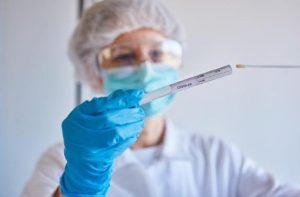As COVID-19 cases reach April numbers, more statewide action possible
By Jerry Nowicki Capitol News Illinois — November 10, 2020SPRINGFIELD – With no signs of slowing, key metrics measuring the spread of COVID-19 – including hospitalizations – continue to push numbers not seen since April and May.
The 4,742 people hospitalized in Illinois due to COVID-19 as of Monday, Nov. 9 marked the highest number since May 8, which was right around the peak of the first wave of the virus. It’s the 16th straight day of increases for hospitalizations, marking an 82 percent increase since the beginning of that 16-day period.
While Gov. J.B. Pritzker lauded positive vaccine news that was reported Monday at his daily briefing in Chicago Tuesday, Nov. 10, he said Illinois is still “locked in a struggle with this virus as winter approaches.”
“Across the state, the majority of our regions are seeing far higher rates of hospitalizations for COVID-19 than they ever did last spring,” Pritzker said. “Outside of Cook and the collar counties, much of Illinois’ communities are experiencing the worst surge that they’ve seen yet.”
With just less than 31 percent of beds available statewide, there were more hospital beds in use at the end of Monday, including non-COVID patients, than there has been at any time during the pandemic.
Region 2 of the state’s mitigation plan has seen hospitalization rates more than double spring peaks while Region 3 has seen hospitalizations more than triple the region’s spring numbers. Region 6 in east-central Illinois has a hospitalization rate 3.5 times higher than the spring, Pritzker said.
The 911 intensive care beds in use by COVID-19 patients statewide were a high since May 30, while the 399 ventilators were a high since June 8. That left about 32 percent of ICU beds and 72 percent of ventilators available statewide.
While bed shortages are a concern, Pritzker said “the number one thing you hear from hospitals isn’t so much ‘do we have the space.’ It’s ‘do we have the staffing.’” He noted the state has put in place measures to allow health care professionals who recently left the field to rejoin it, but the concern over staffing goes beyond Illinois.
Pritzker said he has been in touch with hospital leadership across the state and is keeping open the option of opening field hospitals, but there are no immediate plans to do so.
“They have a message for everyone listening,” he said of hospital leaders, “They implore you to make sure that everyone wears a mask and stops gathering with a large number of people in your homes. They need your help.”
On Monday, Pfizer announced preliminary results that showed a 90 percent effectiveness for a vaccine, although more research is still needed on long-term effects, among other aspects of the vaccine.
“There are more trials ahead to determine if there are safety concerns, if the vaccine offers protection to those with prior COVID-19 exposure, if it protects against severe COVID-19, and if its effects on human immunity lasts an appropriate amount of time,” Pritzker said.
The vaccine still must gain approval from the U.S. food and Drug administration, a process that will take an unknown amount of time, but has often taken several years for other vaccines.
Pritzker said the state stands ready “to build the appropriate logistics chain to distribute vaccines to our state’s residents,” which includes storage of the vaccine at colder than 100 degrees below zero. In October, the state laid out its vaccine plan which would prioritize frontline workers and at-risk populations for the first batch of vaccines which would be expected to arrive in limited supply.
“Whatever the vaccine that comes we’re going to build the capability to deliver that vaccine to the people of Illinois,” he said, noting “we will need a lot of help from the federal government.”
In the meantime, the governor said the state continued to look at ways to prevent the virus from spreading, emphasizing social distancing, masking and staying home.
“As I said last week and yesterday, we’re monitoring the numbers closely and additional statewide action is possible,” he said. “It’s critical to remember that nothing makes a bigger difference in this pandemic than when a community decides to protect your own by wearing masks, by avoiding gatherings, by temporarily closing high-risk, high-exposure businesses, until we get to a place where it’s safer to open again.”
The statewide case positivity rate increased to 12.1 percent, more than tripling in a span of exactly one month. The 12,623 new confirmed and probable cases once again set a one-day record among 101,955 test results reported in the previous 24 hours.
The Illinois Department of Public Health also announced 79 deaths in COVID-19-positive individuals bringing the death toll to 10,289 among 511,183 confirmed and probable cases since the pandemic began.
The state is reporting probable cases along with confirmed cases because it is expanding the use of rapid antigen tests, which the U.S. Centers for Disease Control and Prevention classify as a probable, rather than confirmed case. Antigen tests made up approximately 5,800 of the more than 100,000 test results reported Tuesday, IDPH Director Dr. Ngozi Ezike said.
“We’ve been given hundreds of thousands of this (antigen) test (from the federal government) and we want to use them, but by definition that falls in the probable category,” she said. “If these people had not been tested with the … rapid test and instead had been tested with the traditional (test), they still would have been cases, so it’s just a matter of what testing method was used.”
jnowicki@capitolnewsillinois.com
Three more regions get tighter restrictions that limit gatherings








